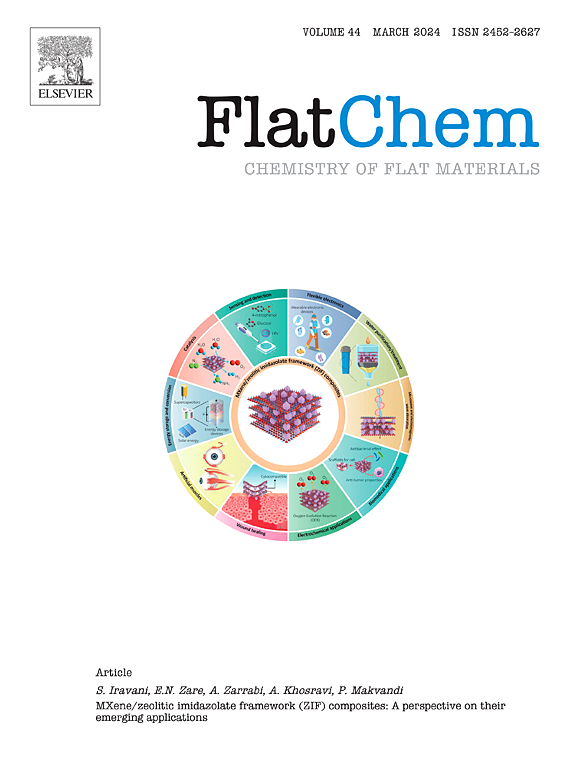从石墨烯到MXenes:利用二维材料的力量增强钠离子电池的性能
IF 6.2
3区 材料科学
Q2 CHEMISTRY, PHYSICAL
引用次数: 0
摘要
在寻求可持续能源存储解决方案的过程中,由于钠资源的丰富和低成本,钠离子电池(sib)已成为锂离子电池的有前途的替代品。在影响sib性能的关键因素中,电极材料的选择是一个关键的决定因素。二维(2D)材料由于其独特的性能和可调特性在这方面引起了极大的关注。本文综述了近年来各种二维材料在钠离子电池技术中的应用进展。具体来说,我们探索了石墨烯、磷烯、过渡金属二硫族化合物(TMDs)、金属有机框架(mof)和MXenes作为sib电极材料的利用。通过对这些材料的合成方法、结构特性和电化学性能的深入分析,本文对它们在提高钠离子电池储能能力方面的潜力提供了有价值的见解。此外,本文还讨论了在sib中实际应用2D材料所面临的挑战和机遇,以及对未来研究方向的展望,旨在实现高效和可扩展的钠离子电池技术。本文章由计算机程序翻译,如有差异,请以英文原文为准。

From graphene to MXenes: Harnessing the power of 2D materials for enhanced sodium-ion battery performance
In the quest for sustainable energy storage solutions, sodium-ion batteries (SIBs) have emerged as promising alternatives to lithium-ion batteries due to the abundance and low cost of sodium resources. Among the key factors influencing the performance of SIBs, the choice of electrode materials stands out as a critical determinant. Two-dimensional (2D) materials have garnered significant attention in this regard owing to their unique properties and tunable characteristics. This comprehensive review delves into recent advancements in the application of various 2D materials for sodium-ion battery technologies. Specifically, we explore the utilization of graphene, phosphorene, transition metal dichalcogenides (TMDs), metal-organic frameworks (MOFs), and MXenes as electrode materials in SIBs. Through an in-depth analysis of the synthesis methods, structural properties, and electrochemical performance of these materials, this paper provides valuable insights into their potential for enhancing the energy storage capabilities of sodium-ion batteries. Furthermore, the challenges and opportunities associated with the practical implementation of 2D materials in SIBs are discussed, along with perspectives on future research directions aimed at realizing efficient and scalable sodium-ion battery technologies.
求助全文
通过发布文献求助,成功后即可免费获取论文全文。
去求助
来源期刊

FlatChem
Multiple-
CiteScore
8.40
自引率
6.50%
发文量
104
审稿时长
26 days
期刊介绍:
FlatChem - Chemistry of Flat Materials, a new voice in the community, publishes original and significant, cutting-edge research related to the chemistry of graphene and related 2D & layered materials. The overall aim of the journal is to combine the chemistry and applications of these materials, where the submission of communications, full papers, and concepts should contain chemistry in a materials context, which can be both experimental and/or theoretical. In addition to original research articles, FlatChem also offers reviews, minireviews, highlights and perspectives on the future of this research area with the scientific leaders in fields related to Flat Materials. Topics of interest include, but are not limited to, the following: -Design, synthesis, applications and investigation of graphene, graphene related materials and other 2D & layered materials (for example Silicene, Germanene, Phosphorene, MXenes, Boron nitride, Transition metal dichalcogenides) -Characterization of these materials using all forms of spectroscopy and microscopy techniques -Chemical modification or functionalization and dispersion of these materials, as well as interactions with other materials -Exploring the surface chemistry of these materials for applications in: Sensors or detectors in electrochemical/Lab on a Chip devices, Composite materials, Membranes, Environment technology, Catalysis for energy storage and conversion (for example fuel cells, supercapacitors, batteries, hydrogen storage), Biomedical technology (drug delivery, biosensing, bioimaging)
 求助内容:
求助内容: 应助结果提醒方式:
应助结果提醒方式:


